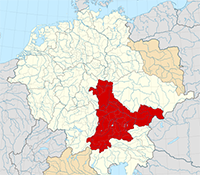Early to Modern Bavaria
People have lived in what is now Bavaria for a very long time. Possibly the earliest were a confederation of Celtic tribes known as the Noricum, after the eastern Norici tribe. The Raeti, another tribe, settled nearby. As with many other peoples in Europe, the Noricum found themselves absorbed by the Roman Empire, about 15 B.C. The Danube River was a key boundary for this new Roman province. The Romans maintained the province of Raeti after absorbing it and made the capital Augusta Vindelicorum, now Augsburg. An at times dizzying array of Germanic invasions occupied Roman settlement in the area, with Germanic tribes from the north and east winning out and mixing in with the defeated inhabitants. The settlement of the Celtic tribe the Baiovarii, about the 6th Century, eventually gave way to the area's being called Bavaria. The Duchy of Bavaria dates to about this time as well, with rulers belonging to the Agilolfing family. Purveyors of another religion, Christian monks from Ireland and Scotland, arrived in the next several decades, spreading their teachings as they went. Another takeover by a foreign power occurred in 788, when the Frankish king Charlemagne took control, incorporating Bavaria into what would eventually the Holy Roman Empire, although that entity didn't officially include Bavaria in its holdings until the 10th Century. Louis the German, a grandson of Charlemagne, referred to himself as King of Bavaria while ruling East Francia, the result of a division of the Frankish empire brought about by the Treaty of Verdun in 843; a number of his successors did the same, ending as did the 9th Century. 
One of Bavaria's strongest antagonists through the years were the Hungarians, who savaged Bavarian forces under Margrave Luitpold at the Battle of Pressburg in 907. Not a half century later, Bavaria had its revenge, as forces under the Holy Roman Emperor Otto the Great defeated Hungarian troops at the 955 Battle of Lechfeld. By that time, Bavaria had been shuttled on to the emperor's brother, Henry, beginning a series of Ottonians ruling as Duke of Bavaria. One byproduct of the imperial victory was a reversal of antagonism. Bavaria and Hungary moved closer together as the 10th Century waned, and a royal marriage in 995 sealed the deal, as the eventual King Stephen I of Hungary married the Bavarian princess Gisela, whose father was Henry II, Duke of Bavaria. 
The Salian dynasty replaced the Ottonian dynasty atop the Bavarian governance structure, beginning with Henry the Black in 1026. A few Salian dukes were also Holy Roman Emperor. One who wasn't an emperor but had a quarrel with the man who occupied that throne was Welf, who became Duke of Bavaria in 1070. The emperor, having more power, took the dukeship from Welf and kept it in his own hands for a time. Welf regained his title in 1096, held it for five years, then gave way to a series of successors, ending with Henry the Lion, in the mid-12th Century. 
Bavaria remained firmly within imperial purview until 1180, when then-Emperor Frederick Barbarossa handed it over to Otto of Wittelsbach. This began the Wittelsbach dynasty, which ruled Bavaria for centuries. Louis IV (right) in 1328 became the first Wittelsbach emperor. Ruling authorities in 1255 divided the land into Upper Bavaria and Lower Bavaria; further subdivisions of those two lands occurred two centuries later, with rulers of those subdivided lands fighting one another for supremacy. A reunion came as the 16th Century dawned. Maximilian I was Duke of Bavaria during the Thirty Years War. For his support, the empire created the Electorate of Bavaria, consisting of Upper Bavaria, Lower Bavaria, and the Upper Palatinate. The rulers had the title Prince-elector of Bavaria. The second Prince-elector named Maximilian opposed the empire in the War of the Spanish Succession, in the early 18th Century. A later Wittelsbach Prince-elector, Charles Albert, also opposed the empire, in the War of the Austrian Succession, in the 1740s. During that war, he became Holy Roman Emperor. Both of those alliances were with France. Bavaria allied with France again during the Napoleonic Wars. With the dissolution of the Holy Roman Empire, in 1806, Bavaria was one of several duchies that became kingdoms. Maximilian IV Joseph, who had been the second Elector of the Palatinate (after Charles Theodore) to rule Bavaria, became the first King of Bavaria. King Maximilian I ruled for 19 years, giving way to his son Ludwig, who was on the throne when the Revolutions of 1848 began. Ludwig gave up his throne, which was taken by his son Maximilian. It that was monarch's son, Ludwig II, who led the kingdom into the German Empire. His brother was on the Bavarian throne for a time and then came Ludwig III, the last Wittelsbach ruler. The German Revolution of 1918 ousted the king, replacing the monarchy with a democratic republic. |
|
Social Studies for Kids
copyright 2002–2025
David White




